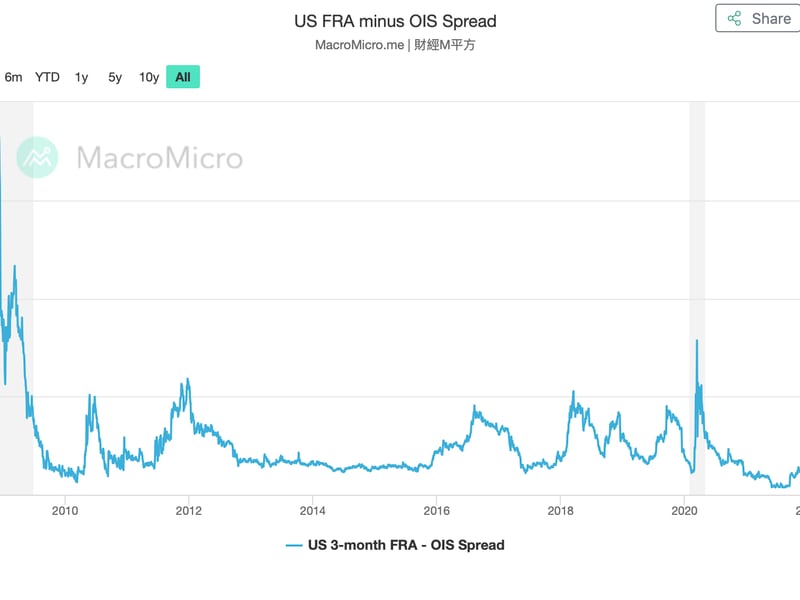Bitcoin Nears $25K as Interbank Funding Stress Indicator Surges to Highest Level Since COVID Crash

Bitcoin (BTC) continued to rally early Tuesday as a key banking sector risk indicator spiked, strengthening the case for a pause in Federal Reserve's (Fed) rate hikes.
The leading cryptocurrency by market value rose to a three-week high of $24,900, extending a three-day winning streak, CoinDesk data show. Prices pretty much reversed the entire drop from $25,000 to $19,500 seen in the second half of February.
The gap between the U.S. three-month forward rate agreement (FRA) and the overnight index swap rate (OIS), also known as the FRA-OIS spread, a measure of how costly it is for banks to borrow U.S. dollars from one another, surged to 54.00, the highest since March 2020, according to data source MacroMicro.
The borrowing and lending between banks is a crucial component of the banking system that helps banks manage their immediate liquidity needs. When the interbank lending market is strained or dysfunctional, banks face greater liquidity risk, which can result in insolvency.
So, the sharp rise in the FRA-OIS spread is a sign of the system reaching a point of vulnerability. That strengthens the case for the Fed to pause its rate hike cycle at next week's meeting or opt for a smaller 25 basis points move instead of the 50 bps raise expected last week. The central bank has lifted the official borrowing cost by 450 basis points in one year, roiling risk assets, including cryptocurrencies.
"Banking sector stress strengthens the case for Fed pause next week. Likely beneficiaries from the financial stress are gold and bitcoin - hard assets," the author of the popular Crypto is Macro Now newsletter told CoinDesk. "Likely beneficiaries from the financial stress are gold and bitcoin, the hard assets."
The surge in the banking stress indicator comes after the failure of three U.S. banks, including the startups-focused Silicon Valley Bank, within five days and has prompted investors to reassess their outlook for interest rates.
The Fed rate hike bets have crumbled in the past 24 hours and the CME's FedWatch tool now suggests a 46% chance that the central bank will keep rates unchanged in the range of 4.5%-4.75% next week.
Markus Thielen, head of research and strategy at crypto services provider Matrixport, said that signs of financial market stress might mean more government guarantees in terms of liquidity. Bitcoin and cryptocurrencies, in general, are widely considered pure liquidity plays.
"Financial market stress indicators have risen to the highest levels since the European debt crisis a decade ago. At the same time, credit default swaps, which measure the cost of insuring bond portfolios against defaults, have increased markedly. Bitcoin has benefited as more government guarantees might mean more money printing," Thielen told CoinDesk.

While the FRA-OIS spread is nowhere close to levels seen during the great financial crisis of 2008, it is significantly higher than in recent weeks.
Per ING, the sharp deviation higher from the recent range has weakened the case for a 50 basis point rate hike.
"It's a market deviation versus the very tight FRA/OIS spread seen in recent weeks. We remarked at the time that such a tight spread meant that the Fed could indeed deliver a 50bp hike at the March meeting, as the system was taking it quite calmly. That's clearly changed in the wake of the Silicon Valley Bank collapse," analysts at ING said in a note to clients on Tuesday.
"The Fed would no doubt prefer the system to look and feel safer. U.S. CPI [inflation data due on Tuesday] is less relevant – the system is key for now," analysts added.
The U.S. Bureau of Labor Statistics (BLS) is scheduled to release inflation figures for February on Tuesday at 12:30 UTC.
According to Reuters, the forecast is for the headline CPI to rise 0.4% month-on-month, bringing the year-on-year rate to 6%, marking a decline from January's 6.4% reading. The core CPI, which excludes the volatile food and energy component, is projected at 0.4% month-on-month and 5.5% year-on-year.








